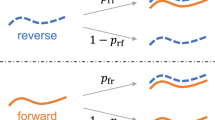Abstract
Fluorescence is highly sensitive to environment, and the distance separating fluorophores and quencher molecules can provide the basis for effective homogeneous nucleic acid hybridization assays. Molecular interactions leading to fluorescence quenching include collisions, ground state and excited state complex formation, and long-range dipole-coupled energy transfer. These processes are well understood and equations are provided for estimating the effects of each process on fluorescence intensity. Estimates for the fluorescein-tetramethylrhodamine donor–acceptor pair reveal the relative contributions of dipole-coupled energy transfer, collisional quenching, and static quenching in several common assay formats, and illustrate that the degree of quenching is dependent upon the hybridization complex formed and the manner of label attachment.




Similar content being viewed by others
Notes
This separation distance assumes the stem regions are included in the rigid helix. However, since the stem portions are not complementary to the target they would have some random coil nature and a somewhat smaller separation distance would result.
References
Walsh, A., Rourke, F. O., & Laio, B. N. (2009). Evaluation of the Abbott RealTime™ CT assay with the BD ProbeTec™ ET assay for the detection of Chlamydia trachomatis in a clinical microbiology laboratory. Diagnostic Microbiology and Infectious Disease, 64, 13–19.
Tang, N., Huang, S., Salituro, J., Mak, W.-B., Cloherty, G., Johanson, J., et al. (2007). A RealTime HIV-1 viral load assay for automated quantitation of HIV-1 RNA in genetically diverse group M subtypes A-H, group O and group N samples. Journal of Virological Methods, 146, 236–245.
Sum, S. S.-M., Wong, D. K.-H., Yuen, M.-F., Yuan, H.-J., Yu, J., Lai, C.-L., et al. (2004). Real-time PCR assay using molecular beacon for quantitation of hepatitis B virus DNA. Journal of Clinical Microbiology, 42, 3438–3440.
Liming, S. H., & Bhagwat, A. A. (2004). Application of a molecular beacon—real-time PCR technology to detect Salmonella species contaminating fruits and vegetables. International Journal of Food Microbiology, 95, 177–187.
Clayton, S. J., Scot, F. M., Walker, J., Callaghan, K., Haque, K., Liloglou, T., et al. (2000). K-ras point mutation detection in lung cancer: comparison of two approaches to somatic mutation detection using ARMS allele-specific amplification. Clinical Chemistry, 46, 1929–1938.
Bernard, P. S., Ajioka, R. S., Kushner, J. P., & Wittwer, C. T. (1998). Homogeneous multiplex genotyping of hemochromatosis mutations with fluorescent hybridization probes. The American Journal of Pathology, 153, 1055–1061.
Emig, M., Saussele, S., Wittor, H., Weisser, A., Reiter, A., Willer, A., et al. (1999). Accurate and rapid analysis of residual disease in patients with CML using specific fluorescent hybridization probes for real time quantitative RT-PCR. Leukemia, 13, 1825–1832.
Zhou, X. P., Waite, K. A., Pilarski, R., Hampel, H., Fernandez, M. J., Bos, C., et al. (2003). Germline PTEN promoter mutations and deletions in Cowden/Bannayan-Riley-Ruvalcaba syndrome result in aberrant PTEN protein dysregulation of the phosphoinositol-3-kinase/akt pathway. American Journal of Human Genetics, 73, 404–411.
Takano, T., Ohe, Y., Sakamoto, H., Tsuta, K., Matsuno, Y., Tateishi, U., et al. (2005). Epidermal growth factor receptor gene mutations and increased copy numbers predict gefitinib sensitivity in patients with recurrent non-small-cell lung cancer. Journal of Clinical Oncology, 23, 6829–6837.
Lakowicz, J. R. (1983). Principles of fluorescence spectroscopy. New York: Plenum Press.
Valeur, B. (2002). Molecular fluorescence: Principles and applications. Weinheim: Wiley-VCH.
Morrison, L. (1999). Homogeneous detection of specific DNA sequences by fluorescence quenching and energy transfer. Journal of Fluorescence, 9, 187–196.
Morrison, L. E. (2003). Fluorescence in nucleic acid hybridization assays. In J. R. Lakowicz (Ed.), Topics in fluorescence spectroscopy (Vol. 7, pp. 69–97). New York: Kluwer.
Ebata, K., Masuko, M., Ohtani, H., & Kashiwasake-Jibu, M. (1995). Nucleic acid hybridization accompanied with excimer formation from two pyrene-labeled probes. Photochemistry and Photobiology, 62, 836–839.
Morrison, L. E. (1988). Time-resolved detection of energy transfer: Theory and application to immunoassays. Analytical Biochemistry, 174, 101–120.
Lakowicz, J. R., & Weber, G. (1973). Quenching of fluorescence by oxygen. A probe for structural fluctuation in macromolecules. Biochemistry, 12, 4161–4170.
Forster, T. (1959). Transfer mechanisms of electronic excitation. Discussions of the Faraday Society, 27, 7–17.
Morrison, L. E., Halder, T. C., & Stols, L. M. (1989). Solution-phase detection of polynucleotides using interacting fluorescent labels and competitive hybridization. Analytical Biochemistry, 183, 231–244.
Solinas, A., Brown, L. J., McKeen, C., Mellor, J. M., Nicol, J. T. G., Thelwell, N., et al. (2001). Duplex scorpion primers in SNP analysis and FRET applications. Nucleic Acids Research, 29, e96.
Tyagi, S., & Kramer, F. R. (1996). Molecular beacons: Probes that fluoresce upon hybridization. Nature Biotechnology, 14, 303–308.
Whitcombe, D., Theaker, J., Guy, S. P., Brown, T., & Little, S. (1999). Detection of PCR products using self-probing amplicons and fluorescence. Nature Biotechnology, 17, 804–807.
Heller, M. J., & Morrison, L. E. (1985). Chemiluminescent and fluorescent probes for DNA hybridization systems. In D. T. Kingsbury & S. Falkow (Eds.), Rapid detection and identification of infectious agents (pp. 245–256). Orlando: Academic Press.
Wittwer, C. T., Herrmann, M. G., Moss, A. A., & Rasmussen, R. P. (1997). Continuous fluorescence monitoring of rapid cycle DNA amplification. Biotechniques, 22, 130–138.
Lee, L. G., Connell, C. R., & Bloch, W. (1993). Allelic discrimination by nick-translation PCR with fluorogenic probes. Nucleic Acids Research, 21, 3761–3766.
Ishiguro, T., Saitoh, J., Yawata, H., Otsuka, M., Inoue, T., & Sugiura, Y. (1996). Fluorescence detection of specific sequence of nucleic acids by oxazole yellow-linked oligonucleotides. Homogeneous quantitative monitoring of in vitro transcription. Nucleic Acids Research, 24, 4992–4997.
Abravaya, K., Huff, J., Marshall, R., Merchant, B., Mullen, C., Schneider, G., et al. (2003). Molecular beacons as diagnostic tools: Technology and applications. Clinical Chemistry and Laboratory Medicine, 41, 468–474.
Author information
Authors and Affiliations
Corresponding author
Rights and permissions
About this article
Cite this article
Morrison, L.E. Basic Principles of Fluorescence and Energy Transfer Applied to Real-Time PCR. Mol Biotechnol 44, 168–176 (2010). https://doi.org/10.1007/s12033-009-9225-1
Published:
Issue Date:
DOI: https://doi.org/10.1007/s12033-009-9225-1




